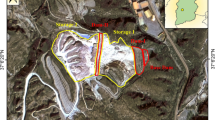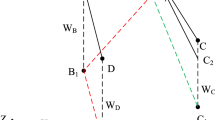Abstract
In this paper, we carried out a combination of permanent scatterer and quasi permanent scatterer time-series InSAR image analyses to extract geometric information over the area of the Three Gorges Dam. For the first time, we measured and analyzed the deformation of the Three Gorges Dam and its surrounding area using 40 SAR images acquired from 2003 to 2008. Our results indicate that the temporal deformation of the left part of the dam has ceased and that the deformation of the dam was influenced by the changing level of the Yangtze River. Seasonal deformation due to varying temperature is also observed. The obtained results agree well with the published results of the Three Gorges Dam deformation obtained by employing conventional survey methods. We also found that there is an area of abnormal subsidence near Zigui County. This paper demonstrates the potential of time-series InSAR image analysis in the monitoring of dam stability and measurement of subsidence.
Similar content being viewed by others

References
Li Q, Zhao X, Cai J A, et al. P wave velocity structure of upper and middle crust beneath the Three Gorges reservoir dam and adjacent regions. Sci China Ser D-Earth Sci, 2009, 52: 567–578
Fourniadis I G, Liu J G, Mason P J. Regional assessment of landslide impact in the three gorges area, China, using ASTER data: Wushan-Zigui. Landslides, 2007, 4: 267–278
Shen C, Sun S, Liu S, et al. Dynamic variations of gravity field in head area of Three Gorges reservoir in recent years (in Chinese). J Geod Geodyn, 2004, 24: 6–13
Yang J, Wu Z. Present conditions and development of dam safety monitoring and control researches home and abroad (in Chinese). J Xi’an Univ Technol, 2002, 18: 26–30
Yan J, Li S. Optimization design of deformation monitoring for TGP’s dam (in Chinese). Yangtze River, 2002, 33: 36–38
Li Z, Liu Z, Wang Z. GPS in dam deformation monitoring (in Chinese). J Wuhan Univ Hydraulic Electr Eng, 1996, 29: 26–29
Guo H. Theory and Application of Earth Observation with Radar (in Chinese). Beijing: Science Press, 2000
Liao M, Lin H. Synthetic Aperture Radar Interferometry—Principle and Signal Processing (in Chinese). Beijing: Survey Press, 2003
Rosen P A, Hensley S, Joughin I R, et al. Synthetic aperture radar interferometry. Proc IEEE, 2000, 88: 333–382
Hanssen R F. Radar Interferometry Data Interpretation and Error Analysis. Dordrecht: Kluwer Academic Publishers, 2001
Madsen S, Zebker H, Martin J. Topographic mapping using radar interferometry: Processing techniques. IEEE Trans Geosci Remote Sens, 1993, 31: 246–256
Liao M, Wang T, Lu L, et al. Reconstruction of DEMs from ERS-1/2 tandem data in mountainous area facilitated by SRTM data. IEEE Trans Geosci Remote Sens, 2007, 45: 2325–2335
Gabriel A K, Goldstein R M, Zebker H A. Mapping small elevation changes over large areas: Differential radar interferometry. J Geophys Res, 1989, 94: 9183–9191
Wang C, Zhang H, Shan X, et al. Application SAR interferometry for ground deformation detection in China. Photogramm Eng Remote Sens, 2004, 70: 1157–1166
Ge, L, Chang H, Rizos C. Mine subsidence monitoring ssing multi-source satellite SAR images. Photogramm Eng Remote Sens, 2007, 73: 259–266
Zebker H. On the derivation of coseismic displacement fields using differential radar interferometry: The landers earthquake. J Geophys Res, 1994, 99: 19617–19634
Shan X J, Ma J, Wang C L, et al. Co-seismic ground deformation and source parameters of Mani M7.9 earthquake inferred from spaceborne D-InSAR observation data. Sci China Ser D-Earth Sci, 2004, 47: 481–488
Zebker H, Villasenor A J. Decorrelation in interferometric radar echoes. IEEE Trans Geosci Remote Sens, 1992, 30: 950–959
Goldstein R. Atmospheric limitations to repeat-pass interferometry. Geophys Res Lett, 1995, 22: 2517–2520
Ding X, Li Z, Zhu J, et al. Atmospheric effects on InSAR measurements and their mitigations. Sensors, 2008, 8: 5426–5448
Ferretti A, Prati C, Rocca F. Permanent scatterers in SAR interferometry. IEEE Trans Geosci Remote Sens, 2001, 39: 8–20
Ferretti A, Prati C, Rocca F. Nonlinear subsidence rate estimation using permanent scatterers in differential SAR interferometry. IEEE Trans Geosci Remote Sens, 2000, 38: 2202–2212
Colesanti C, Ferretti A, Novali F, et al. SAR monitoring of progressive and seasonal ground deformation using the permanent scatterers technique. IEEE Trans Geosci Remote Sens, 2003, 41: 1685–1701
Perissin D, Prati C, Engdahl M E, et al. Validating the SAR wavenumber shift principle with the ERS Envisat PS coherent combination. IEEE Trans Geosci Remote Sens, 2006, 44: 2343–2351
Ferretti A, Savio G, Barzaghi R, et al. Submillimeter accuracy of InSAR time series: Experimental validation. IEEE Trans Geosci Remote Sens, 2007, 45: 1142–1153
Perissin D. Validation of the sub-metric accuracy of vertical positioning of PS’s in C Band. IEEE Lett Geosci Remote Sens, 2008, 5: 502–506
Wang Y, Liao M, Li D, et al. Subsidence velocity retrieval from long term coherent targets in radar interferometric stacks (in Chinese). Chin J Geophys, 2007, 50: 598–604
Perissin D, Rocca F. High-accuracy urban DEM using permanent scatterers. IEEE Trans Geosci Remote Sens, 2006, 44: 3338–3347
Perissin D, Ferretti A. Urban target recognition by means of repeated spaceborne SAR Images. IEEE Trans Geosci Remote Sens, 2007, 45: 4043–4058
Kampes B M. Radar Interferometry Persistent Scatterer Technique. Dordrecht: Springer, 2006.
Hooper A, Segall P, Zebker H. Persistent scatterer interferometric synthetic aperture radar for Crustal deformation analysis, with application to Volcán Alcedo, Galápagos. J Geophys Res, 2007, 112: B07407, doi: 10.1029/2006JB004763
Mora O, Mallorqui J J, Broquetas A. Linear and nonlinear terrain deformation maps from a reduced set of interferometric SAR images. IEEE Trans Geosci Remote Sens, 2003, 41: 2243–2253
Perissin D, Ferretti A, Piantanida R, et al. Repeat-pass SAR interferometry with partially coherent targets. Fringe 2007, Frascati (Italy), 26–30 November, 2007
Hilley G, Burgmann R, Ferretti A, et al. Dynamics of slow-moving landslides from permanent scatterer analysis. Science, 2004, 304: 1952–1955
Wang T, Perissin D, Liao M, et al. Deformation monitoring by long term D-InSAR Analysis in Three Gorges area, China. Geoscience and Remote Sensing Symposium, IEEE International, 2008
Dai H, Su H. Stability against sliding in intake dam section of Yangtze River Three Gorges Project (in Chinese). Rock Soil Mechanics, 2006, 27: 643–647
Touzi R, Lopes A, Bruniquel J, et al. Coherence estimation for SAR imagery. IEEE Trans Geosci Remote Sens, 1999, 37: 135–149
Biggs N L. Discrete Mathematics. Oxford: Claredon Press, 1985
Zebker H, Chen K. Accurate estimation of correlation in InSAR observations. IEEE Lett Geosci Remote Sens, 2005, 2: 124–127
Gatelli F, Guamieri A M, Parizzi F, et al. The wavenumber shift in SAR inferometry. IEEE Trans Geosci Remote Sens, 1994, 32: 855–865
Liu G. Geology engineering overview of the Three Gorges Project (in Chinese). Hydrogeol Eng Geol, 1993, 20: 56–57
Huang S, Yin H, Jiang Z. Deformation Monitoring Data Processing (in Chinese). Wuhan: Wuhan University Press, 2004
Liao M, Tian X, Zhao Q. Missions and applications of TerraSAR- X/Tandem-X (in Chinese). J Geomatics, 2007, 32: 44–46
Soergel U, Thoennessen U, Brenner A, et al. High-resolution SAR data: New opportunities and challenges for the analysis of urban areas. IEEE Proc Radar Sonar Navigation, 2006, 153: 294–300
Author information
Authors and Affiliations
Corresponding author
Rights and permissions
About this article
Cite this article
Wang, T., Perissin, D., Rocca, F. et al. Three Gorges Dam stability monitoring with time-series InSAR image analysis. Sci. China Earth Sci. 54, 720–732 (2011). https://doi.org/10.1007/s11430-010-4101-1
Received:
Accepted:
Published:
Issue Date:
DOI: https://doi.org/10.1007/s11430-010-4101-1



